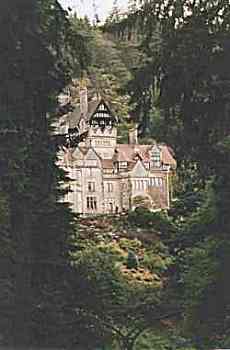Cragside
|
|
Cragside is a country house near Rothbury in Northumberland, England. Built into a rocky hillside above a 404 hectare forest garden, it was the country home of William George Armstrong and has been in the care of the National Trust since the late 1970s. It was the first house in the world to be lit using hydroelectric power.
Cragside, named after Cragend Hill above the house, was built in 1863 as a modest, two-storey country lodge, but was subsequently extended to designs by Norman Shaw, transforming it into an elaborate mansion in the Free Tudor style. At one point, the building included an astronomical observatory and a scientific laboratory.
In 1868, a hydraulic engine was installed, with water being used to power labour-saving machines such as laundry equipment, a rotisserie and a hydraulic lift. In 1870, water from one of the estate's lakes was used to drive a Siemens dynamo in what was probably the world's first hydroelectric power station. The resultant electricity was used to power an arc lamp installed in the Gallery in 1878. The arc lamp was replaced in 1880 by Joseph Swan's incandescent lamps in what Swan considered 'the first proper installation' of electric lighting.
The generators, which also provided power for the farm buildings on the estate, were constantly extended and improved to match the increasing electrical demand in the house.
The house is surrounded by one of Europe's largest rock gardens, and a large collection of mostly coniferous trees, among which one Douglas-fir 59 m tall is the tallest tree in England.
External links
- Cragside House, Gardens and Estate (The National Trust) (http://www.nationaltrust.org.uk/hbcache/property178.htm)
- Cragside (The Heritage Trail) (http://en.wikipedia.org/w/index.php?title=Cragside&action=submit)
- Cragside History and Pictures (http://www.ejr.ndo.co.uk/crag.html)

